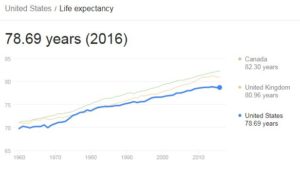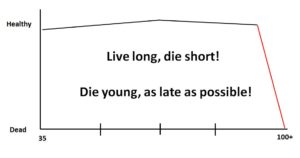Does Your Life-planning Go Beyond the Actuarial Tables? It should.

In my multiple roles as recruiter, retirement coach, and career transition specialist, I have the good fortune to talk with some amazing, talented and successful people who have entered into their “third age” of life. That’s the new extended and unchartered territory between the end of mid-career jobs and parenting duties and the beginning of dependent old age.
I often ask the question: “How long do you expect to live?”
Typical answers are – –
- I haven’t thought about it.
- I don’t want to think about it
- Oh, probably the average life span.
- I guess my genetics will determine that.
A few – very few – will volunteer an actual number.
One exception surfaced recently when I spoke with a 53-year-old business exec who is unwavering in predicting her ultimate demise (as in, dead) at or around 75 because of a collection of infirmities that have beset her immediate family, past and present – cancer, dementia to name the most common. She has set a firm “full retirement” age of 65 so she can prepare for the 10-year downward slide that she feels is inevitable.
As usual, being the hammer that I am and with her innocently becoming an unsuspecting nail, I opposed her position by burying her in stats, facts, positive self-help clichés and – well, were you to hear a recording of the one-way exchange, you would appreciate why it’s unlikely she and I will have a further conversation. She was gracious enough to sign off the conversation with a pleasant “so nice to meet you, Gary. Hope you have a good weekend.”
This was on a Tuesday.
It’s a stylistic blind-spot that I’ve been unable to shake, to which my grown children will gladly attest. In their 40’s, they still can sense when another “dad lecture” is about to emerge and they remain skilled in evasion tactics. 
They’ve turned out pretty darn good without having to experience the pile of pontifications poised for presentation in that crowded section of my mental hard-drive.
But, I remain undeterred in my belief that the self-fulfilling prophecy still has substance. We can think our way into almost anything, including an early demise.
Or not.
The field of biocognition, i.e. the mind and body communicating with each other, is teaching us that when we believe something our biology will comply.
So I guess if I choose to buy into the myth that my DNA is my destiny or if I accept that 80 is about the average age that I should expect to live to, well I subconsciously and subtly start paving the road to that end.
My daily life could get pretty miserable if I bought into only living to the average male life-span in the U.S. which is – yikes – going backward and now is 78.69 years.
Since I just hit double-seven last month, I’m in fret-and-worry, end-of-life-planning territory if I let the averages guide my thinking. I should be buying a cemetery plot since that’s sort of expected of my demographic. But I’m not buying because several grand for a box and the culturally-infused ritual and “celebration” that I can’t attend just doesn’t compute for me.
My progeny have done well enough to pay to convert me to an urn of ashes. And I’m sure they’ll agree to spread the results, without fanfare, in the Colorado River in the riffled-run 50 feet below the bridge over the at Ouray Ranch in Grand County, CO. That stretch has gifted me with a number of 20” rainbow trout over the years.
So, unlike the aforementioned exec, I choose to be an outlier. I stay camped on my goal to make 112.5 as the number for the end of my dependent old age. And, my dependent-old-age period – the morbidity stage – is to be two weeks or less. Or, ideally, non-existent as in face-down in the previously referenced stretch of the Colorado River having fooled another of those 20” rainbows.
Oh, I get it – there may be a truck out there on the interstate with my number on it that could make this my last blog. Or some critical organ cells could decide to go rogue. But what good is there in that visualization?
I believe my biology is following my beliefs.
 If I don’t look my age, which I don’t, it’s not my genetics. If I don’t act my age, which I don’t, it’s about my beliefs. If I don’t feel 77 – well I can’t say what that’s about because I’ve never been 77 before. I just know I’m more energized, motivated and purposeful than at any other point in my life and I’m convinced my biology is listening and tagging along.
If I don’t look my age, which I don’t, it’s not my genetics. If I don’t act my age, which I don’t, it’s about my beliefs. If I don’t feel 77 – well I can’t say what that’s about because I’ve never been 77 before. I just know I’m more energized, motivated and purposeful than at any other point in my life and I’m convinced my biology is listening and tagging along.
So, with total deference to all the actuaries in the world (aren’t you glad somebody likes and wants that job?), I’m ignoring their rear-view mirror research and going the outlier route. I’m out to bend that average life span back up but I need companions to make that happen. See my earlier appeal here.
Maybe you are up for it – maybe not. Maybe it’s easier to accept actuarial fate and have your mind help your body check out earlier than necessary. But maybe you accept the validity of a biocognitive relationship that is the on-ramp to becoming a longevity outlier and feeling good enough to enjoy it.
It’s a choice. There are very few things in life that we have full control over. Our thinking is one of those. Any of us can be rebels with a worthy cause that question and challenge the culturally-imposed portals that determine the way to transition through life.
We have the option to step out of that collective reality and make the actuaries look silly. I suspect they wouldn’t mind.




 I’m sure that was a lot of information that you didn’t need/want to know.
I’m sure that was a lot of information that you didn’t need/want to know.
 That by itself is huge. But, with his new surge of energy and confidence, he has also begun to swing his diet to more of a plant-based diet.
That by itself is huge. But, with his new surge of energy and confidence, he has also begun to swing his diet to more of a plant-based diet.







 Maybe we were smarter then and recognized that retirement is an unnatural act and doesn’t happen in nature. We’re the only species smart enough (???) to come up with the concept of intentionally going backward (look up the definition of retire) and planning it into our lives.
Maybe we were smarter then and recognized that retirement is an unnatural act and doesn’t happen in nature. We’re the only species smart enough (???) to come up with the concept of intentionally going backward (look up the definition of retire) and planning it into our lives.





 One, our venture beyond middle-age today is putting us into unfamiliar territory. We haven’t been here before – living this much longer. One hundred years ago, we checked out around 50, mostly succumbing to what retired Stanford geriatric physician Dr. Walter Bortz refers to as “lightning events” i.e. infectious diseases, injuries/accidents, malignancies, poisonings, wars.
One, our venture beyond middle-age today is putting us into unfamiliar territory. We haven’t been here before – living this much longer. One hundred years ago, we checked out around 50, mostly succumbing to what retired Stanford geriatric physician Dr. Walter Bortz refers to as “lightning events” i.e. infectious diseases, injuries/accidents, malignancies, poisonings, wars.
 What I will rail against is off-the-cliff, labor-to-leisure, vocation-to-vacation retirement – the traditional model that emanated from a political decision in 1935, and that grew and became deeply embedded with the help of the financial services industry over the past 40-50 years.
What I will rail against is off-the-cliff, labor-to-leisure, vocation-to-vacation retirement – the traditional model that emanated from a political decision in 1935, and that grew and became deeply embedded with the help of the financial services industry over the past 40-50 years.